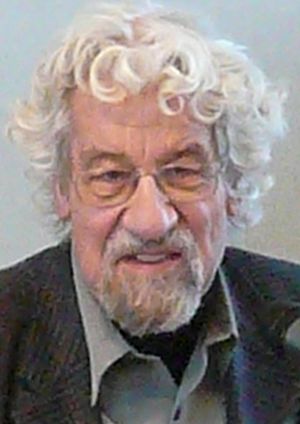Hans-Peter Dürr facts for kids
Quick facts for kids
Hans-Peter Dürr
|
|
|---|---|

Dürr in 2007
|
|
| Born | 7 October 1929 |
| Died | 18 May 2014 (aged 84) Munich, Germany
|
| Occupation | Physicist |
| Awards | Order of Merit of the Federal Republic of Germany, Right Livelihood Award |
Hans-Peter Dürr (born October 7, 1929 – died May 18, 2014) was a German scientist. He was a physicist who studied tiny particles and how things work in the universe. He also thought a lot about how science connects to ideas and beliefs. Dürr believed scientists should use their knowledge responsibly. He worked to make sure technology was used for peace, not war. In 1987, he won the Right Livelihood Award for speaking out against a missile defense plan called "Star Wars." He also worked to turn advanced technology into tools for peace.
Contents
About Hans-Peter Dürr
Hans-Peter Dürr was born in Stuttgart, Germany. He studied physics and earned his Ph.D. in 1956. He worked at the Max Planck Institute for Physics in Munich. He was a director there many times between 1978 and 1992. He also taught physics at the Ludwig Maximilian University in Munich until 1997.
Dürr was a close colleague of the famous physicist Werner Heisenberg. He focused on understanding atomic particles and the rules of quantum physics. He also studied elementary particles and gravity. He worked with Heisenberg to try and find a "unified field theory." This theory would explain how all the basic forces in the universe are connected.
Hans-Peter Dürr also cared deeply about social justice. He helped fund groups that protested against a nuclear fuel plant in Germany.
Working for Peace and the Environment
In the 1980s, Dürr became a strong voice for peace. He was part of the Pugwash Conferences on Science and World Affairs. These meetings bring scientists together to talk about reducing global dangers. In 1983, he helped start the "Scientists' Initiative: Responsibility for Peace." This group led to a big meeting of 3,300 scientists. They signed a statement against more nuclear weapons.
Dürr was a leading critic of the US Strategic Defense Initiative (SDI). This plan was also known as "Star Wars." It aimed to build a shield in space to stop missiles. Dürr believed this would make the world less safe.
In 1986, Dürr suggested a "World Peace Initiative." He thought it should be as big as the "Star Wars" plan. This initiative would focus on solving environmental problems and achieving fairness for everyone. This idea later became the Global Challenges Network. This network also received the Right Livelihood Award along with Dürr.
Later in his life, Dürr worked on environmental issues. He was on the board of Greenpeace Germany. He also advised China on how to develop without harming nature. In 1996, he joined a group that advised the UN Secretary General on city planning.
Dürr was a member of the Club of Rome. This group discusses global challenges like poverty and pollution. He believed in sustainable living. This means using resources wisely so there's enough for future generations. He focused on using energy efficiently.
In 2005, Dürr helped create the Potsdam Manifesto. This was a new call for peace and responsibility, like the famous Russell–Einstein Manifesto from 1955. Many scientists from around the world signed it.
From 2006 until he passed away, Dürr was a founding member of the World Future Council. This group works for a fair and sustainable future. He also supported a campaign to create a United Nations Parliamentary Assembly. This would give people more say in how the United Nations works.
Awards and Recognition
Hans-Peter Dürr received many awards for his work:
- Award of Merit in 1956.
- Right Livelihood Award in 1987. This is sometimes called the "Alternative Nobel Prize."
- Waldemar-von-Knoeringen-Award in 1989.
- Ecology Award „Goldene Schwalbe“ in 1990.
- Natura Obligat Medaille in 1991.
- Elise and Walter Haas International Award in 1993.
- Medal `München leuchtet' in Gold in 1996.
- Honorary Doctor Dr.phil. h.c, from University Oldenburg in 2002.
- Großes Verdienstkreuz des Bundesverdienstorden der Bundesrepublik Deutschland (Federal Cross of Merit) in 2004.
Making a Difference
Hans-Peter Dürr was a member of many important groups. These groups worked on science, peace, and the environment. Some of them include:
- Deutsche Akademie der Naturforscher Leopoldina, a German science academy.
- Vereinigung Deutscher Wissenschaftler, a group of German scientists.
- Pugwash Conferences on Science and World Affairs, which won the Nobel Peace Prize in 1995.
- Greenpeace Deutschland, an environmental organization.
- Global Challenges Network, which he helped start.
- Club of Rome, a group focused on global challenges.
- Academia Scientiarum et Artium Europaea, a European academy of sciences and arts.
- International Physicians for the Prevention of Nuclear War (which won the Nobel Peace Prize in 1985).
Books He Wrote
Hans-Peter Dürr wrote or helped write many books. These books covered topics like physics, philosophy, and the future of our world. Here are a few:
- What is Life? Scientific Approaches and Philosophical Positions (2002)
- Unified Theories of Elementary Particles (1982)
- Werner Heisenberg, Gesammelte Werke (co-editor, 9 volumes, 1985–1993)
- Das Netz des Physikers (The Physicist's Net, 1988)
- Respekt vor der Natur - Verantwortung für die Natur (Respect for Nature - Responsibility for Nature, 1994)
- Die Zukunft ist ein unbetretener Pfad (The Future is an Untrodden Path, 1995)
- Wir erleben mehr als wir begreifen (We Experience More Than We Understand, 2001)
- Auch die Wissenschaft spricht nur in Gleichnissen (Science Also Speaks Only in Parables, 2004)
- Liebe - Urquelle des Kosmos – Ein Gespräch über Naturwissenschaft und Religion (Love - Primal Source of the Cosmos – A Conversation about Science and Religion, 2008)
See also
 In Spanish: Hans-Peter Dürr para niños
In Spanish: Hans-Peter Dürr para niños

